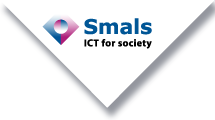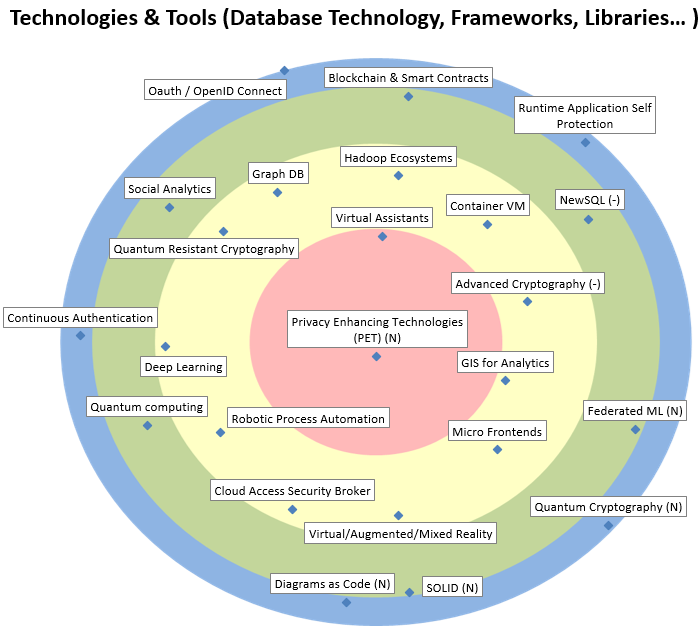| Virtual Assistants |
Reply automatically to questions or utterances, using a conversational interface as basic channel, that accepts chat or speech. Possible applications are: website guidance, helpdesk assistance, querying analytics systems (conversational analytics), or simplification of procedures. |
| Privacy Enhancing Technologies (PET) |
Technologies to maximize the usability and usefulness of data consumed by applications, software, and information systems and minimize the amount of personal data used in these applications. PETs strive to maximize data security. Examples are pseudonymization and differential privacy. |
| Advanced Cryptography |
Advanced cryptography is cryptography that goes beyond the well known crypto work horses such as digital signatures. It allows to reconcile functional requirements with strong security and privacy requirements, which is would otherwise be impossible or at least very complex. |
| Container VM |
Containers are not perfectly isolated, virtual machines are too heavyweight. Container VM technology aims to bridge the gap by making very lightweight but well isolated vm’s, perfectly suited to run a container. Useful for multitenant Kubernetes and FPaaS platforms. |
| Hadoop Ecosystems |
Hadoop Ecosystems implement Big Data distributed storage (HDFS), access (Hive, Impala), distributed computing (MapReduce, Spark), transfer (Sqoop, Kafka, Flume), configuration, monitoring, and management modules, in one integrated environment consisting of several nodes. |
| Graph DB |
Databases based on and/or oriented towards graphs, with nodes (entities) connected through edges (relations). They are very useful in graph analytics, but could also serve in miscellaneous production systems. |
| Quantum Resistant Cryptography |
Cryptographic algorithms considered secure against an attack performed by a quantum computer. Most relevant are the NIST standardization procedure and lattice-based crypto |
| Deep Learning |
Important focus area of AI. Architectures such as Recurrent/Convolutional Neural Nets, GANs, etc. learn hierarchical representations of the data, corresponding to different levels of abstractions, largely from the raw data. Toolkits include TensorFlow, Caffe, Keras,… |
| Robotic Process Automation |
Robotic Process Automation is a process automation technology in which software robots can take over keyboard/mouse and other controls to simulate the work of human workers, enabling automation without altering existing systems. |
| Cloud Access Security Broker |
On-premises or cloud-based security policy enforcement point, placed between cloud service consumers and cloud service providers to combine and interject enterprise security policies as the cloud-based resources are accessed. This point could do encryption and/or pseudonymization. |
| Virtual/Augmented/Mixed Reality |
UI technologies offering an immersive experience, using altered or completely simulated environments in which the user senses and interacts with virtual entities. Potential uses in public sector could be (explorational) Analytics and field work (inspection). |
| Micro Frontends |
In analogy with microservices on the server side, micro front-ends allow the piecemeal development and deployment of an end-user application. The success of this technology will be determined by the quality of the frameworks/platforms combining these ‘pieces’. |
| GIS for Analytics |
Analytical software that integrates with GIS (Geographical Information Systems). Allows to represent the results of the analytical software geographically. |
| NewSQL |
NewSQL Databases combine the scalability and performance of NOSQL DB’s with the ACID principles of RDBMS. Like the traditional DB’s, they support the relational model and SQL. This makes them more suited to replace these DB’s in older applications being re-engineered to increase resilience. |
| Blockchain & Smart Contracts |
Blockchain & smart contracts technology enable a reduction or even elimination of central or intermediary parties. Storage & computation are performed by multiple parties in a network. A verification mechanisms guarantees the correct application of the rules & tamper-proofness of the data. |
| Social Analytics |
The automatic processing and analysis of data from internal and external social media to extract useful information. Most of Big Data Analytics solutions have connectors to exploit these kinds of resources. |
| Quantum computing |
Quantum computing is based on quantum-mechanical phenomena. It might in the future allow more powerful simulations and analysis than today. Its fundamentals are strongle deviating from the ones in classical computers. This is reflected in new programming languages such as Q#. |
| SOLID |
Solid lets people store their data securely in decentralized data stores called Pods. All data in a pod is accessible via the Solid Protocol. When data is stored in someone’s pod, they control who and what can access it. |
| Federated ML |
Methods to train ML models on distributed systems where also the training data samples are distributed, locally stored on separate nodes, and cannot be exchanged. |
| Runtime Application Self Protection |
Runtime Application Self Protection (RASP) is a security technology that is built or linked into an application or application runtime environment, and is capable of controlling application execution and detecting and preventing real-time attacks. |
| Oauth / OpenID Connect |
Standards for authentication / authorization relevant in the domains of mobile applications and REST architectures. |
| Continuous Authentication |
Methods for continuous verification whether the same specific person who logged into a device is still using it. |
| Diagrams as Code |
Several interesting tools now exist to define your diagrams along with your code and then to generate them graphically, allowing the diagrams to be kept more consistent with the code, to be versioned, and to be managed more efficiently. |
| Quantum Cryptography |
Quantum cryptography is the science of exploiting quantum mechanical properties to perform cryptographic tasks. The best known example of quantum cryptography is quantum key distribution which offers an information-theoretically secure solution to the key exchange problem. |

